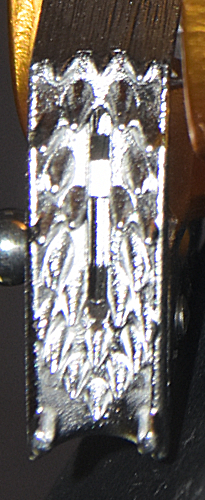Technical Details
I acquired my Beal Hold Up from Expé-Spelemat in 2016.
 The Beal Hold
Up is a right-handed chest ascender, but it has a rather unusual shape for a chest ascender. This ascender is 82 mm. tall, 72 mm.
wide, 59 mm. thick, and weighs 156 g. The ascender shell is an irregular gold-anodized shape bent
from 4.0 mm. aluminum sheet. The rope channel is formed by
bending the right side of the ascender into a U. The rope
channel is 16 mm. wide. The main sling attachment
point is located behind the cam on a tab that is bent back perpendicular to the rear side of the shell, and a rubber pad covers the end of this tab. This accounts for the rather large thickness of this ascender.
A
second attachment point is located above the cam, also behind
the rope channel. This hole is shaped like a "P" on its side, with the straight side on top. It is sized to accept 20 mm. webbing or a carabiner. A 13.9 mm hole is punched in the front of the rope channel, opposite the large area of the "P" hole in the back. The left side of the shell is bent on an
inclined axis to form another U. A hole drilled through both
sides of the U accepts a 6 mm. semi-tubular rivet. The cam and cam spring
are mounted on this rivet. The head of the rivet is in the front. The pivot is centered 46 mm. from the inside of the
rope groove. There is a stamped cam stop near the cam pivot, but it is placed too high to contact the cam.
The Beal Hold
Up is a right-handed chest ascender, but it has a rather unusual shape for a chest ascender. This ascender is 82 mm. tall, 72 mm.
wide, 59 mm. thick, and weighs 156 g. The ascender shell is an irregular gold-anodized shape bent
from 4.0 mm. aluminum sheet. The rope channel is formed by
bending the right side of the ascender into a U. The rope
channel is 16 mm. wide. The main sling attachment
point is located behind the cam on a tab that is bent back perpendicular to the rear side of the shell, and a rubber pad covers the end of this tab. This accounts for the rather large thickness of this ascender.
A
second attachment point is located above the cam, also behind
the rope channel. This hole is shaped like a "P" on its side, with the straight side on top. It is sized to accept 20 mm. webbing or a carabiner. A 13.9 mm hole is punched in the front of the rope channel, opposite the large area of the "P" hole in the back. The left side of the shell is bent on an
inclined axis to form another U. A hole drilled through both
sides of the U accepts a 6 mm. semi-tubular rivet. The cam and cam spring
are mounted on this rivet. The head of the rivet is in the front. The pivot is centered 46 mm. from the inside of the
rope groove. There is a stamped cam stop near the cam pivot, but it is placed too high to contact the cam.
The cam is a plated steel casting. The cam radius increases from 34 to 52 mm. over an angle of 37°, giving a 33° cam angle. The cam has number of small conical radial teeth.
The tooth pattern is (3.4)(1S1.2S2)^2(3.2.1)(BB) where "BB" stands for two bars.
A stamped spring-loaded manual safety is riveted to the cam toe. A pin with a ball end is riveted to the cam to provide for thumbing the safety open. The
normal action of the spring holds the safety against the cam.
When the cam is opened, the shell interferes with the safety,
thus preventing opening the cam. If the safety is moved away
from the cam (opposing the spring), it will clear the shell and
the cam will open. At full open the safety can be released and
the spring will hold the safety against the back of the shell.
This provides a means of locking the cam open.
The front of ascender is printed with the Beal logo, an up-pointing arrow
and "HOLD UP." The rear is printed with "EN 567:2013," "Ø8-13mm," "EN 12481:2006-B," "•Ø 10 - 13 mm," "100 kg," "CE0120," a book-with-an-"i" icon, and "IdN : 0112 05 16."
The Beal Hold Up is strange-looking chest ascender. The shape deviates from the common design. The tab for the attachment point projects back toward the caver, and while not as painful as it looks, I still appreciate the rubber padding. Worse, locating the attachment point behind the cam causes the ascender to tip a great deal under load, reducing climbing efficiency. I do not like this design for that reason.
The ascender well made. All sharp edges have been
removed. The attachment points are not very well-rounded, but a small file or sandpaper can easily correct this.
The Beal Hold Up is essentially identical to the Edelweiss TB16.

For far more content, use a larger monitor and a full-width window.
Hundreds of cell phone users complained and asked me to for a simpler, mobile friendly site. In particular, they wanted me to limit each page to a small number of pictures and minimize my use of text. This new site provides what they asked for.

